
Gavialidae is a family of large semiaquatic crocodilians with elongated, narrow snouts. Gavialidae consists of two living species, the gharial and the false gharial, both occurring in Asia. Many extinct members are known from a broader range, including the recently extinct Hanyusuchus. Gavialids are generally regarded as lacking the jaw strength to capture the large mammalian prey favoured by crocodiles and alligators of similar size so their thin snout is best used to catch fish, however the false gharial has been found to have a generalist diet with mature adults preying upon larger vertebrates, such as ungulates.

Allodaposuchus is an extinct genus of crocodyliforms that lived in what is now southern Europe during the Campanian and Maastrichtian stages of the Late Cretaceous. Although generally classified as a non-crocodylian eusuchian crocodylomorph, it is sometimes placed as one of the earliest true crocodylians. Allodaposuchus is one of the most common Late Cretaceous crocodylomorphs from Europe, with fossils known from Romania, Spain, and France.

Boverisuchus is an extinct genus of planocraniid crocodyliforms known from the middle Eocene of Germany and western North America. It was a relatively small crocodyliform with an estimated total length of approximately 2.2–3.6 metres (7.2–11.8 ft).

Borealosuchus is an extinct genus of crocodyliforms that lived from the Late Cretaceous to the Eocene in North America. It was named by Christopher Brochu in 1997 for several species that had been assigned to Leidyosuchus. The species assigned to it are: B. sternbergii, the type species, from the Maastrichtian of Colorado, Montana, North Dakota, South Dakota, and Wyoming; B. acutidentatus, from the Paleocene of Saskatchewan; B. formidabilis, from the Paleocene of North Dakota; B. griffithi, from the Paleocene of Alberta; and B. wilsoni, from the Eocene of Wyoming. B. formidabilis is particularly well-known, represented by the remains of many individuals from the Wannagan Creek site in North Dakota.
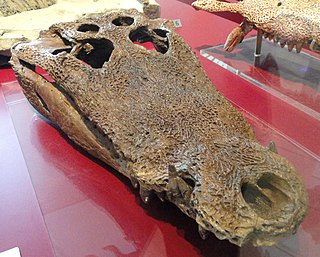
Leidyosuchus is an extinct genus of alligatoroid from the Late Cretaceous of Alberta. It was named in 1907 by Lawrence Lambe, and the type species is L. canadensis. It is known from a number of specimens from the middle Campanian age Dinosaur Park Formation. It was a medium-sized alligatorid, with a maximum skull length greater than 40 centimeters (16 in).
Argochampsa is an extinct genus of eusuchian crocodylomorph, usually regarded as a gavialoid crocodilian, related to modern gharials. It lived in the Paleocene of Morocco. Described by Hua and Jouve in 2004, the type species is A. krebsi, with the species named for Bernard Krebs. Argochampsa had a long narrow snout, and appears to have been marine in habits.

Eusuchia is a clade of neosuchian crocodylomorphs that first appeared in the Early Cretaceous, which includes modern crocodilians. Along with Dyrosauridae and Sebecosuchia, they were the only crocodyliformes who survived the K-Pg extinction.

Alligatoroidea is one of three superfamilies of crocodylians, the other two being Crocodyloidea and Gavialoidea. Alligatoroidea evolved in the Late Cretaceous period, and consists of the alligators and caimans, as well as extinct members more closely related to the alligators than the two other groups.
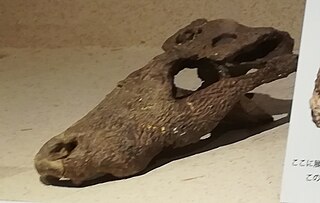
Navajosuchus is an extinct genus of alligatorine crocodylian. Its fossils have been found in the Paleocene-age Nacimiento Formation of the San Juan Basin, New Mexico. It was named in 1942 by Charles C. Mook, and the original type species was N. novomexicanus. N. novomexicanus was based on AMNH 5186, a partial skull collected in 1913. Later research showed that Navajosuchus novomexicanus was the same as the earlier-named Allognathosuchus mooki. However, A. mooki does not belong to the genus Allognathosuchus, and so the name of the crocodilian becomes Navajosuchus mooki. Under whichever name is used, this animal would have been a generalized predator of the Nacimiento floodplains. It was the most common Nacimiento Formation crocodilian, found in both the Puercan and Torrejonian faunal assemblages.

Eothoracosaurus is an extinct monospecific genus of eusuchian crocodylomorphs found in Eastern United States which existed during the Late Cretaceous period. Eothoracosaurus is considered to belong to an informally named clade called the "thoracosaurs", named after the closely related Thoracosaurus. Thoracosaurs in general were traditionally thought to be related to the modern false gharial, largely because the nasal bones contact the premaxillae, but phylogenetic work starting in the 1990s instead supported affinities within gavialoid exclusive of such forms. Even more recent phylogenetic studies suggest that thoracosaurs might instead be non-crocodilian eusuchians.
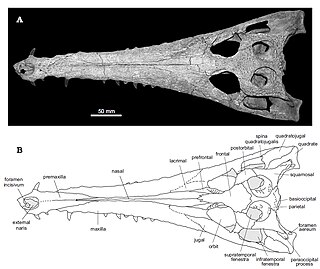
Eosuchus is an extinct genus of eusuchian crocodylomorph, traditionally regarded as a gavialoid crocodilian. It might have been among the most basal of all gavialoids, lying crownward of all other known members of the superfamily, including earlier putative members such as Thoracosaurus and Eothoracosaurus. Fossils have been found from France as well as eastern North America in Maryland, Virginia, and New Jersey. The strata from which specimens have been found date back to the late Paleocene and early Eocene epochs.
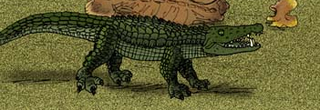
Planocrania is an extinct genus of eusuchian crocodyliforms from what is now China. Two species are currently known to belong to the genus.
Prodiplocynodon is an extinct genus of basal crocodyloid crocodylian. It is one of the only crocodyloids known from the Cretaceous and existed during the Maastrichtian stage. The only species of Prodiplocynodon is the type species P. langi from the Lance Formation of Wyoming, known only from a single holotype skull lacking the lower jaw.

Stangerochampsa is an extinct genus of globidontan alligatoroid, possibly an alligatorine or a stem-caiman, from the Late Cretaceous of Alberta. It is based on RTMP.86.61.1, a skull, partial lower jaws, and partial postcranial skeleton discovered in the late Campanian–early Maastrichtian-age Horseshoe Canyon Formation. Stangerochampsa was described in 1996 by Wu and colleagues. The type species is S. mccabei. The generic name honors the Stanger family, the owners of the ranch where the specimen was found, and the species name honors James Ross McCabe, who discovered, collected, and prepared it. Stangerochampsa is described as "small to medium–sized"; the type skull is 20.0 centimetres (7.9 in) long from the tip of the snout to the occipital condyle, and is 13.0 centimetres (5.1 in) wide at its greatest, while the thigh bone is 14.2 centimetres (5.6 in) long. It had heterodont dentition, with large crushing teeth at the rear of the jaws.

Thecachampsa is an extinct genus of gavialoid crocodylian, traditionally regarded as a member of the subfamily Tomistominae. Fossils have been found from the eastern United States in deposits of Miocene age. Those named in the 19th century were distinguished primarily by the shape of their teeth, and have since been combined with T. antiquus. More recently erected species were reassigned from other genera, although their assignment to Thecachampsa has since been questioned.

Gavialoidea is one of three superfamilies of crocodylians, the other two being Alligatoroidea and Crocodyloidea. Although many extinct species are known, only the gharial Gavialis gangeticus and the false gharial Tomistoma schlegelii are alive today, with Hanyusuchus having become extinct in the last few centuries.
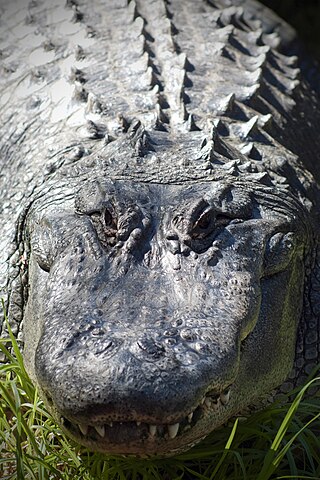
Brevirostres is a paraphyletic group of crocodilians that included alligatoroids and crocodyloids. Brevirostres are crocodilians with small snouts, and are distinguished from the long-snouted gharials. It is defined phylogenetically as the last common ancestor of Alligator mississippiensis and Crocodylus niloticus and all of its descendants. This classification was based on morphological studies primarily focused on analyzing skeletal traits of living and extinct fossil species, and placed the gharials outside the group due to their unique skull structure, and can be shown in the simplified cladogram below:

Planocraniidae is an extinct family of eusuchian crocodyliforms known from the Paleogene of Asia, Europe and North America. The family was coined by Li in 1976, and contains three genera, Boverisuchus, Duerosuchus and Planocrania. Planocraniids were highly specialized crocodyliforms that were adapted to living on land. They had extensive body armor, long legs, and blunt claws resembling hooves, and are sometimes informally called "hoofed crocodiles".

Allodaposuchidae is an extinct clade of eusuchians that lived in Europe during the Late Cretaceous (Santonian-Maastrichtian).
Portugalosuchus is an extinct genus of eusuchian crocodyliform that was possibly a basal crocodylian – if so then it would be the oldest known crocodylian to date. The type species is P. azenhae, described in 2018, and it is known from the Late Cretaceous (Cenomanian)-aged Tentugal Formation in Portugal. A 2021 morphological study recovered Portugalosuchus within Crocodylia as a member of Gavialidae closely related to similar "thoracosaurs", while also noting that it might also possibly be outside of Crocodylia completely. A 2022 tip dating analysis incorporating both morphological and DNA data placed Portugalosuchus outside of Crocodylia, as the sister taxon of the family Allodaposuchidae. A cladogram simplified after that analysis is shown below:




















